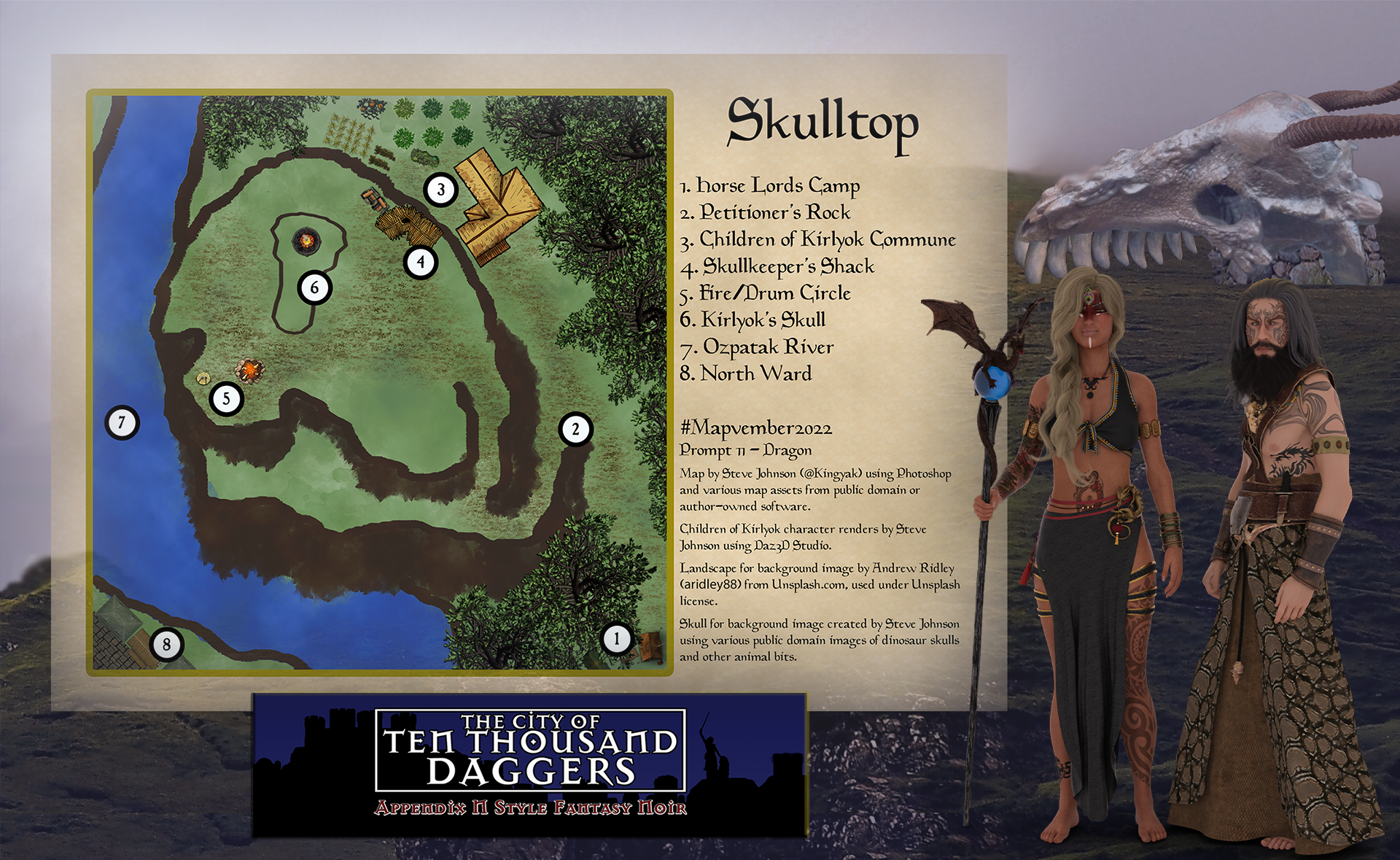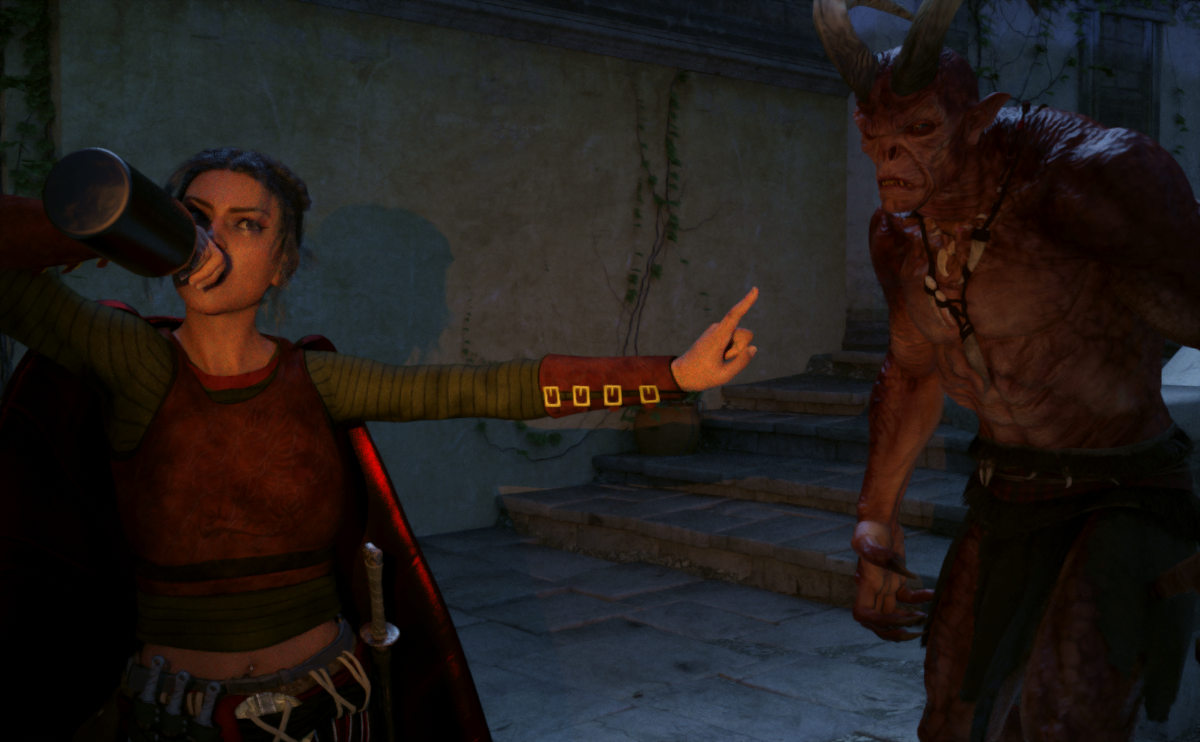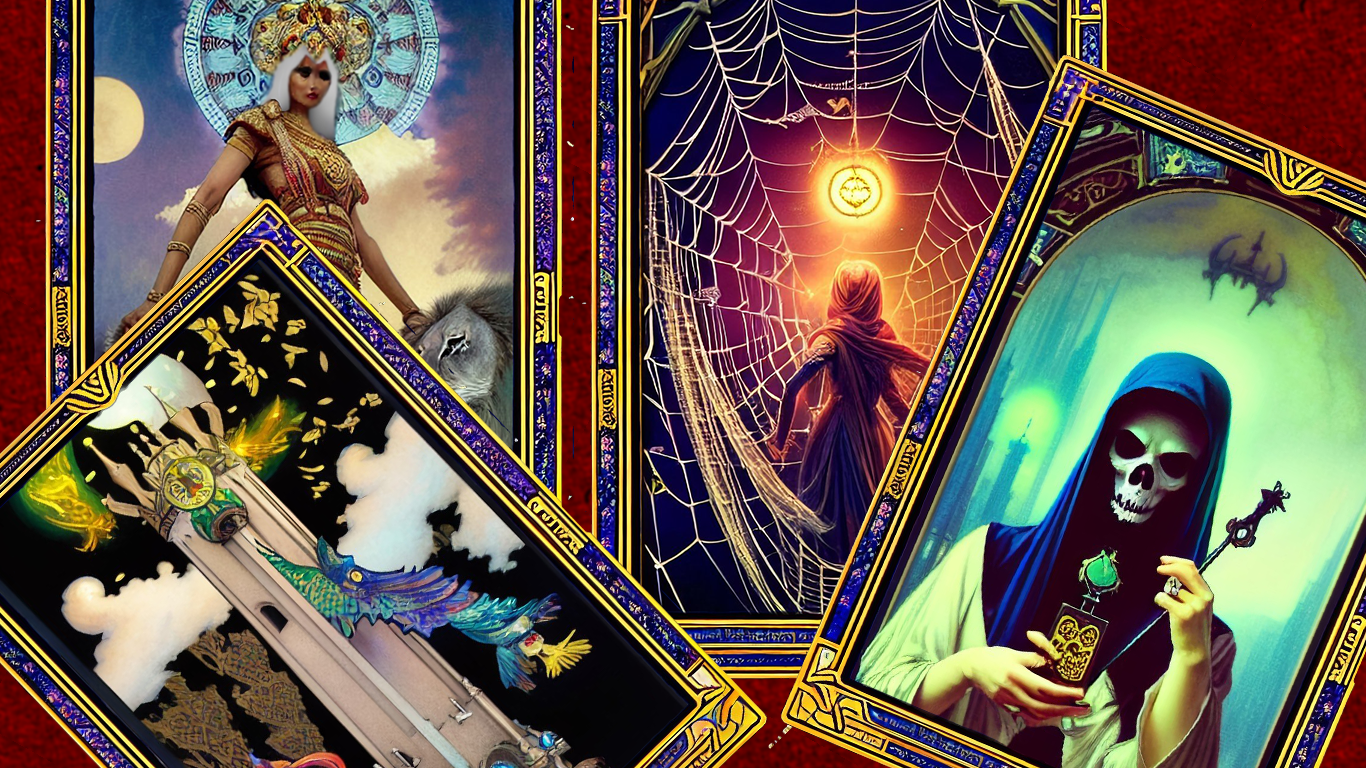We may earn money or products from the companies mentioned in this post.
Editor’s Note: This was originally posted to Patreon before I started the C10KD page. The current version can be found here. The game mechanics in the table are from an older version of Cinemechanix.
No blog this week due to the holiday, but I do have a new chunk of the City of 10,000 Daggers for patrons.
Situated on a rocky outcropping on the banks of the Elfelite River not far from the Necropolis, the Skull of Kirlyok is said to be all that remains of the great dragon Kirlyok, who protected the city of Khesvaros in the times of the Dragon Pacts. The main dome of the skull stands as tall as three tall men and is entered through the long hallway formed by the bones of the wyrm’s upper jaw and snout. The long, intricately decorated fangs propping up the front of the skull allow all but the tallest to enter without fear of contact with the smaller teeth above. It is claimed that one who follows the proscribed ritual inside the skull can achieve great insight into his destiny.
Of course, entering the skull isn’t as easy as walking between the pillars formed by Kirlyok’s teeth. The skull is protected by powerful magic that brings death to anyone who enters without the blessings of the Children of Kirlyok, a group of mystics charged with protecting the site. Gaining the keepers’ blessing is easier said than done. In order to seek an audience, the petitioner (or petitioners) must arrive at the foot of the path leading up to the skull at dawn and remain there until moonrise. Throughout the day, members of the cult may approach the petitioner and ask him questions (or they may not). If they decide to grant an audience (some claim that offering tribute to the Children improves one’s chances), one of the mystics will come down shortly after the moon rises and lead the petitioner up the path to the Children of Kirlyok’s fire circle, where he must share stories and a hypnotic drink (which they refer to as Kirlyok’s Blood) with the mystics while answering a series of increasingly bizarre questions. If the Children of Kirlyok determine that the petitioner is worthy, they will charge him with a quest to complete in order to gain entrance to the skull.
Once the petitioner provides proof that he has accomplished his quest, the mystics will set a time for him to enter the skull. At the appointed time, the petitioner must participate in a short ritual that involves drinking a thick and bitter potion and reciting oaths in the ancient dragon language. When the ritual is done, the petitioner is led to the entrance of the skull. Inside, the skull will be filled with fragrant smoke coming from braziers burning with unnaturally-colored fire and steam coming from a pit filled with heated rocks. Throughout the ritual, Children of Kirlyok will enter the skull to add fresh rocks or water to the pit. Those participating will be told to sit within the dome and meditate on their questions or concerns, but otherwise given little instruction. Game Information:
- Kirlyok’s Blood is slightly psychoactive. Characters who drink it may experience mild hallucinations and altered perception for up to 24 hours. The details are up to the GM.
- The Children of Kirlyok are more likely to offer a quest to those whose motives serve the greater good. Those who seek the wisdom of the skull for selfish or petty reasons will be deemed unworthy. The nature and difficulty of the quest can vary considerably, as can the ease in deciphering exactly what they mystics want (they’re often cryptic when describing the quest). In general, those who plan to use wisdom from the skull for ends that coincide with the mystics’ goals (whatever they may be) will receive simpler and more straightforward quests.
- The substance that characters ingest before entering the skull is very psychoactive, and the heat and trippy environment inside the skull heightens the effects. However, the heat can also harm characters participating in the ritual. For every hour that a character remains within the skull he makes a default roll (d12 + Hero Die). If the result is less than (5 + Number of hours the ritual has gone on), he suffers a Wound. If the result is higher than (20 – Number of hours the ritual has gone on), he experiences a hallucination. To determine the nature of the hallucination, roll on the Hallucination Table. The GM should do his best to make the hallucinations trippy and surreal.
- In addition to expanding a participant’s mind, the substances used in the ritual help neutralize the toxic gasses that seep into the skull from a fissure in the rock. Anyone who enters the skull without the ritual preparations being made suffers a Wound for every minute they spend inside.
- Wounds suffered inside the skull (whether from heat, noxious gasses, or hallucinatory battle) heal naturally at the rate of 1 per hour once the character leaves.
Hallucination Table
- The character finds himself before Argalak the Weigher, who deems him unworthy and sentences him to 100 years of servitude to the Lord of Bones, all of which the character experiences during the hallucination. The character will suffer nightmares for the next 3d10 days. During that time, lack of proper sleep causes the character to suffer a Die Limit of d10 and his Fu rating is reduced by 1d4 points (roll daily).
- The character is attacked by an enemy (monster, rival, legendary hero or villain, etc.) who is more powerful than the character (Hero Factor is 1.5 times the character’s Hero Factor). A character who dies in a hallucinatory battle is considered Mostly Dead and will be dragged out of the skull by the Children of Kirlyok.
- The character is attacked by an enemy who is his equal (Hero Factor equal to the character’s).
- The character is attacked by a weaker enemy (Hero Factor 75% of the charcter’s).
- The character experiences a vivid dream in which he is imprisoned, enslaved, stranded in a hostile environment, or otherwise forced to endure extreme hardship.
- The character becomes relives an unpleasant memory from his past.
- The character experiences an unpleasant event from his (possible) future.
- The character experiences a hallucination in which he suffers shame and humiliation.
- The character finds himself standing before Argalak the Weigher, who accurately measures the worth of his soul. If the character is unworthy, he suffers bad dreams (see #1). If he is deemed worthy, he has good luck (see #20). If he is deemed neither, he hallucinates being reincarnated and living a completely new life with no memory of his current one, but there are no special effects.
- The character finds himself face to face with Kirlyok the Dragon. The dragon offers the character a bargain: if he can prove his worth, the Dragon will answer his questions. If he fails, the Dragon will eat him. If the character declines, he wakes up in the skull. If he accepts, he must offer evidence that he is worthy. For each piece of evidence, the character makes a Presence roll against the Dragon (who opposes with a roll of 2d12). If the character wins a roll and gets Raises, he may temporarily bank them. If the character wins 5 rolls before Kirlyok does, the dragon will truthfully answer 1 question plus an additional question for each Raise that the character banked. If the dragon wins five rolls first, he eats the character, which renders the character Mostly Dead.
- The character experiences a pleasant hallucination.
- The character relives a pleasant memory from his past.
- The character experiences a vivid hallucination where his wildest dreams come true.
- The character experiences an event from his (possible) future that reveals useful information.
- The character hallucinates being an unseen watcher of an actual event (past, present, or future) that reveals useful information about a current or future storyline or subplot.
- The character meets a well-known scholar, mentor (living or dead), or other knowledgeable person who will truthfully answer one question.
- The character meets a famous or legendary person (noble, hero, etc.) who will provide the character advice on one subject that the hallucination is familiar with. This insight gives the character +1 in the appropriate Edge. For example, the character might meet a legendary warrior and get a +1 to Swordsmanship.
- As #17, but the person will also truthfully answer 1 question.
- The character meets a mythic figure (God, Unicorn, Fairy King, Dragon, etc.) who favors the character. The character gets +1 to the Basic Ability of his choice.
- The character finds himself before Argalak the Weigher and is deemed worthy. The character gets a +1 bonus to the Basic Ability of his choice. In addition, he receives a d12 bonus die that he can add to any roll. When the character uses the bonus die, it drops to a d10. It continues to drop by one die type each time it’s used until it drops to zero.





